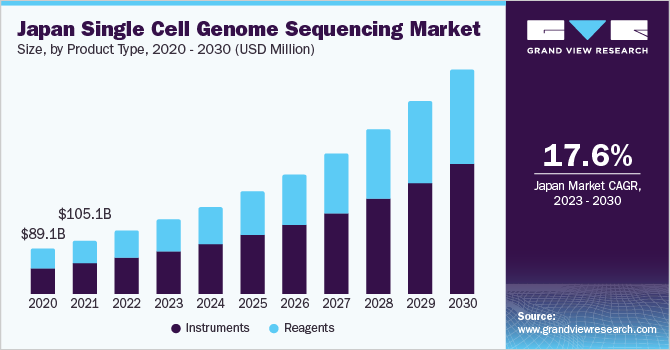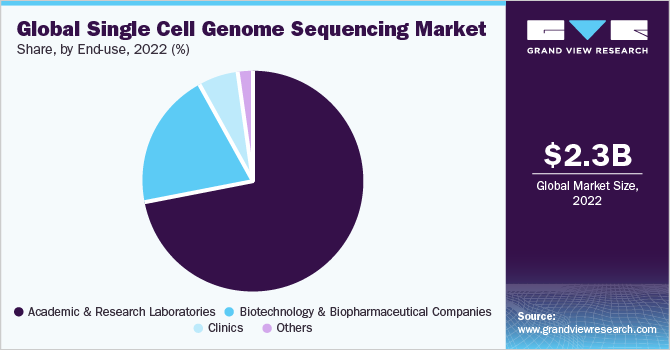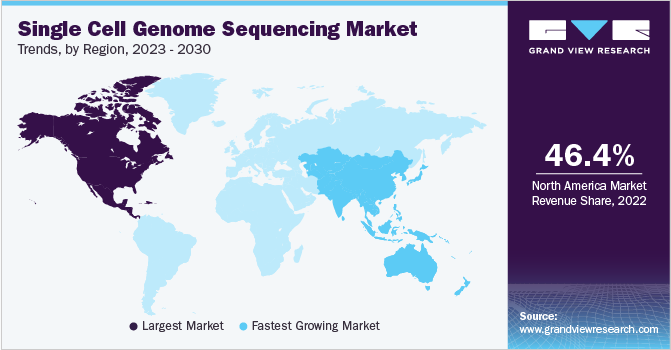- Home
- »
- Biotechnology
- »
-
Single Cell Genome Sequencing Market Size Report, 2030GVR Report cover
![Single Cell Genome Sequencing Market Size, Share & Trends Report]()
Single Cell Genome Sequencing Market Size, Share & Trends Analysis By Product Type (Instruments, Reagents), By Disease Area (Cancer, Immunology), By Technology, By Workflow, By Application, By End-use, By Region, And Segment Forecasts, 2023 - 2030
- Report ID: GVR-2-68038-352-2
- Number of Pages: 120
- Format: Electronic (PDF)
- Historical Range: 2018 - 2021
- Industry: Healthcare
Report Overview
The global single cell genome sequencing market size was estimated at USD 2.28 billion in 2022 and is expected to grow at a compound annual growth rate (CAGR) of 16.1% from 2023 to 2030. Some of the key trends triggering the market growth are the increasing prevalence of chronic diseases like cancer, diabetes, and arthritis; advanced technology and latest collaborations; and rising geriatric population. In addition, companies are placing greater emphasis on product development, further fueling the market's expansion.

The growth of the market is being significantly influenced by the notable technological advancements in single-cell genome sequencing (SCGS). For instance, the collaboration between Bio-Rad Laboratories, Inc. and Illumina, Inc., aimed at developing an innovative workflow for SCGS analysis. The successful outcome of this collaboration led to the launch of a cutting-edge SCGS solution. These advanced platforms not only offer intuitive analysis software solutions but are also cost-effective, making them a promising addition to the market. As an advanced technology, this procedure is widely used in a variety of research such as in neurology, immunology, cancer, and other such diseases and medical streams. Medical institutes are leveraging SCGS to enhance their complex microbial ecosystems and multicellular organism diseases. Considering these significant findings, SCGS is anticipated to emerge as a valuable asset in the healthcare sector in the coming years.
The COVID-19 pandemic has had a positive impact on the market. Since 2020 and continuing even after the initial phase after the pandemic subsided, many research institutions conducted research studies regarding the effects of single cell sequencing on cells from a COVID-19-positive patient, revealing crucial insights about both. These research efforts have resulted in continuous advancements in the market, leading to an exponential growth.
Product Type Insights
In terms of product, the instruments segment dominated the market in 2022, with a revenue share of 57.43%. This dominance can be primarily attributed to the accelerated development and adoption of technologically advanced instruments and solutions, specifically designed to keep pace with the dynamic changes in healthcare technological advancements. This segment is expected to witness the fastest CAGR of 16.2% over the forecast period due to the increased focus of market players on developing and manufacturing these instruments. Such efforts aim to expand their market presence and seize opportunities to enter new markets.
Technology Insights
In terms of technology, the PCR segment dominated the market in 2022 with a revenue share of 27.77%. Due to heavy investments in R&D, PCR is a widely recognized technology when it comes to genome sequencing, highly coveted by market leaders and research institutes. NGS is poised to emerge as the fastest-growing technology segment with a CAGR of 17.1% over the forecast period. This remarkable growth can be attributed to extensive R&D activities and its diverse applications in cancer-related investigations.
Genome sequencing has evolved significantly over the past few years due to constant technological advancements. For instance, in March 2023, researchers at ETH Zurich used a new approach using single-cell genome sequencing to analyze the DNA from two different T-cells that were obtained from the same period. This sequencing data revealed 28 somatic mutations that differentiated the two T-cells and identified any mitochondrial DNA changes. It was inferred that this new method could potentially allow scientists to study various impacts of somatic mutations in a host of diseases.
Workflow Insights
The workflow segment is divided into genomic analysis, single cell isolation, and sample preparation. The genomic analysis segment dominated the market in 2022, with a market size of 69.08%. This dominance can be attributed to the recent surge in funding for research and development capabilities and the widespread adoption of genomic analysis products. As a result, this segment is projected to experience the fastest CAGR of 16.8% during the forecast period.
These recent developments have also created new opportunities for mutation rate quantification, rare cell type identification, and other diagnoses and treatments. Genomic analysis allows comprehensive identification, measurement, and comparison of genomic features like DNA sequence, gene expression, and other regulatory and functional annotations. This analysis allows companies to study cells in depth, ensuring lucrative growth for this segment. For instance, a research publication released on 30th May 2023, showcased how genomic analysis studies have revealed candidate genes associated with milk production and adaptive traits in goat breeds. These findings exemplify the potential and significance of genomic analysis in uncovering valuable insights in diverse fields of research.
Disease Area Insights
The disease area segment is divided into cancer, immunology, prenatal diagnosis, neurobiology, microbiology, and others. The cancer segment dominated the market in 2022 with a revenue share of 34.95%. The increasing prevalence of prostate, colorectal, and breast cancer is projected to generate lucrative opportunities for market growth. Notably, according to the American Cancer Society, cancer ranks as the second leading cause of mortality in the U.S.
With an increase in cancer incidences, there has been a complementary increase in the number of research studies and experiments being conducted. Therefore, rise in cancer incidences is also causing a growth in the SCGS market. For instance, in October 2022, researchers from UBC and the BC Cancer Research Institute conducted cancer-related research, which showed that single cell genome sequencing provided new insights into deadly cancers. The researchers were able to sequence the genomes of individual cells from the biopsies of 158 BC Cancer patients, allowing them to observe the processes of evolution within each individual cell.
Application Insights
The application segment is divided into circulating cells, cell differentiation/reprogramming, genomic variation, subpopulation characterization, and others. The circulating cells segment dominated the market in 2022, with a revenue share of 28.45%. This is due to an increase in clinical application of circulating tumor cells (CTCs) as biomarkers for cancer detection, used as genomic profilers for sequence mutations and other such applications.
CTCs allow blood circulation within the primary tumor and regulate tumor metastasis to fight cancer. Due to increasing R&D opportunities and growing number of research, studies, and clinical trials, the circulating cells segment is forecasted to grow at a significant CAGR of 16.2% over the coming years. For instance, in January 2023, researchers at IIT Delhi worked in collaboration with Fluidigm Corporation, US, to develop an innovative and deep dictionary learning to detect circulating cells in the bloodstream, called unCTC.
The prenatal diagnosis segment is anticipated to grow at the fastest CAGR of 17.1% over the forecast period owing to the increasing number of medical tests and procedures that are performed during pregnancy to detect potential health issues or abnormalities in the developing fetus coupled with higher resolution and accuracy of SCGS compared to traditional sequencing methods.
End-use Insights
The end-use segment is divided into academic & research laboratories, biotechnology & biopharmaceutical companies, clinics, and others. The academic & research laboratories segment dominated the market in 2022, with a revenue share of 71.85%. This growth is attributed to the rise in genomic centers, increase in life science research funding, and growing number of medical colleges and institutions in major regions.

The biotechnology & biopharmaceutical companies segment is anticipated to grow at the fastest CAGR over the forecast period. This is due to the increasing dependency of medical institutions and hospitals on these companies for research access, results, and other equipment and related contingencies. Due to their strong market presence and desire to enter the single-cell genome sequencing market, many biotechnology companies are pursuing different competitive strategies to stretch their lead. As a result, this segment is anticipated to grow significantly.
Regional Insights
North America dominated the regional market in 2022, with a revenue share of 46.38%. This dominance can be attributed to several factors, including the increasing incidence of cancer and other chronic diseases in the region. In addition, the continuous advancements in technology and research and development efforts by companies in North America have contributed to this lead. Moreover, the rise in the number of genomic clinics in the region has further boosted its position in the market.

Asia Pacific is anticipated to grow at the fastest CAGR of 17.4% over the forecast period. One of the primary drivers of the growth is the rising geriatric population, leading to an increased prevalence of chronic diseases among patients. In addition, the region is anticipated to witness significant advancements in healthcare infrastructure, driven by developing countries' efforts to boost their economies.
Key Companies & Market Share Insights
Major companies are continually striving for progress to establish themselves as market leaders. Consequently, the market is witnessing numerous activities such as acquisitions, product launches, and the implementation of competitive strategies. Moreover, companies are actively expanding their research and development initiatives while introducing cutting-edge technological advancements in the industry.
For instance, in October 2022, Oxford Nanopore Technologies PLC announced a collaboration with 10x Genomics, aimed at streamlining the workflow to enable the sequencing of full length transcripts in single reads on Oxford Nanopore devices. This collaboration will facilitate single cell sequencing accessible to any laboratory, thereby increasing efficiency and cost reduction benefits. Some prominent players in the global single cell genome sequencing market include:
-
Bio-Rad Laboratories
-
10x Genomics
-
Novogene
-
Fluidigm
-
BGI
-
Illumina, Inc.
-
Oxford Nanopore Technologies
-
Pacific Biosciences
-
Thermo Fisher Scientific, Inc.
-
QIAGEN
-
F. Hoffmann-La-Roche Ltd.
Single Cell Genome Sequencing Market Report Scope
Report Attribute
Details
Market size value in 2023
USD 2.66 billion
Revenue forecast in 2030
USD 7.55 billion
Growth rate
CAGR of 16.1% from 2023 to 2030
Base year for estimation
2022
Historical data
2018 - 2021
Forecast period
2023 - 2030
Report updated
September 2023
Quantitative units
Revenue in USD million/billion and CAGR from 2023 to 2030
Report coverage
Revenue forecast, company ranking, competitive landscape, growth factors, and trends
Segments covered
Product type, technology, workflow, disease area, application, end-use, region
Regional scope
North America; Europe; Asia Pacific; Latin America; MEA
Country scope
U.S.; Canada; Germany; U.K.; France; Italy; Spain; Denmark; Sweden; Norway; China; Japan; India; South Korea; Australia; Thailand; Brazil; Mexico, Argentina; South Africa; Saudi Arabia, UAE; Kuwait
Key companies profiled
Bio-Rad Laboratories; 10x Genomics; Novogene; Fluidigm; BGI; Illumina, Inc.; Oxford Nanopore Technologies; Pacific Biosciences; Thermo Fisher Scientific, Inc.; QIAGEN; F Hoffmann-La Roche Ltd.
Customization scope
Free report customization (equivalent up to 8 analyst’s working days) with purchase. Addition or alteration to country, regional & segment scope.
Pricing and purchase options
Avail customized purchase options to meet your exact research needs.
Global Single Cell Genome Sequencing Market Report Segmentation
This report forecasts revenue growth at global, regional, and country levels and provides an analysis of the latest trends in each of the sub-segments from 2018 to 2030. For this report, Grand View Research has segmented the global single cell genome sequencing market report based on product type, technology, workflow, disease area, application, end-use, and region:
-
Product Type Outlook (Revenue, USD Million, 2018 - 2030)
-
Instruments
-
Reagents
-
-
Technology Outlook (Revenue, USD Million, 2018 - 2030)
-
NGS
-
PCR
-
qPCR
-
Microarray
-
MDA
-
-
Workflow Outlook (Revenue, USD Million, 2018 - 2030)
-
Genomic Analysis
-
Single Cell Isolation
-
Sample Preparation
-
-
Disease Area Outlook (Revenue, USD Million, 2018 - 2030)
-
Cancer
-
Immunology
-
Prenatal Diagnosis
-
Neurobiology
-
Microbiology
-
Others
-
-
Application Outlook (Revenue, USD Million, 2018 - 2030)
-
Circulating Cells
-
Cell Differentiation/Reprogramming
-
Genomic Variation
-
Subpopulation Characterization
-
Others
-
-
End-use Outlook (Revenue, USD Million, 2018 - 2030)
-
Academic & Research Laboratories
-
Biotechnology & Biopharmaceutical Companies
-
Clinics
-
Others
-
-
Regional Outlook (Revenue, USD Million, 2018 - 2030)
-
North America
-
U.S.
-
Canada
-
-
Europe
-
Germany
-
U.K.
-
France
-
Italy
-
Spain
-
Denmark
-
Sweden
-
Norway
-
-
Asia Pacific
-
Japan
-
China
-
India
-
South Korea
-
Australia
-
Thailand
-
-
Latin America
-
Brazil
-
Mexico
-
Argentina
-
-
Middle East and Africa (MEA)
-
South Africa
-
Saudi Arabia
-
UAE
-
Kuwait
-
-
Frequently Asked Questions About This Report
b. The global single cell genome sequencing market size was estimated at USD 2.28 billion in 2022 and is expected to reach USD 2.66 billion in 2023.
b. The global single cell genome sequencing market is expected to grow at a compound annual growth rate of 16.1% from 2023 to 2030 to reach USD 7.55 billion by 2030.
b. PCR segment accounted for the major revenue share of around 28% in 2022. This is attributable to the high adoption of these technologies by academic institutes to investigate genomic profiles in single-cell-oriented studies.
b. Some key players operating in the single cell genome sequencing market include Bio-Rad Laboratories; 10x Genomics; Novogene; Fluidigm; BGI; Illumina, Inc.; Oxford Nanopore Technologies; Pacific Biosciences; Thermo Fisher Scientific, Inc.; QIAGEN; and F Hoffmann-La Roche Ltd.
b. Key factors that are driving the market growth include an increasing number of product launches by key players and high R&D investments in single-cell genomics market space.
Share this report with your colleague or friend.
![gvr icn]()
NEED A CUSTOM REPORT?
We can customize every report - free of charge - including purchasing stand-alone sections or country-level reports, as well as offer affordable discounts for start-ups & universities. Contact us now
![Certified Icon]()
We are GDPR and CCPA compliant! Your transaction & personal information is safe and secure. For more details, please read our privacy policy.
We are committed towards customer satisfaction, and quality service.
"The quality of research they have done for us has been excellent."





